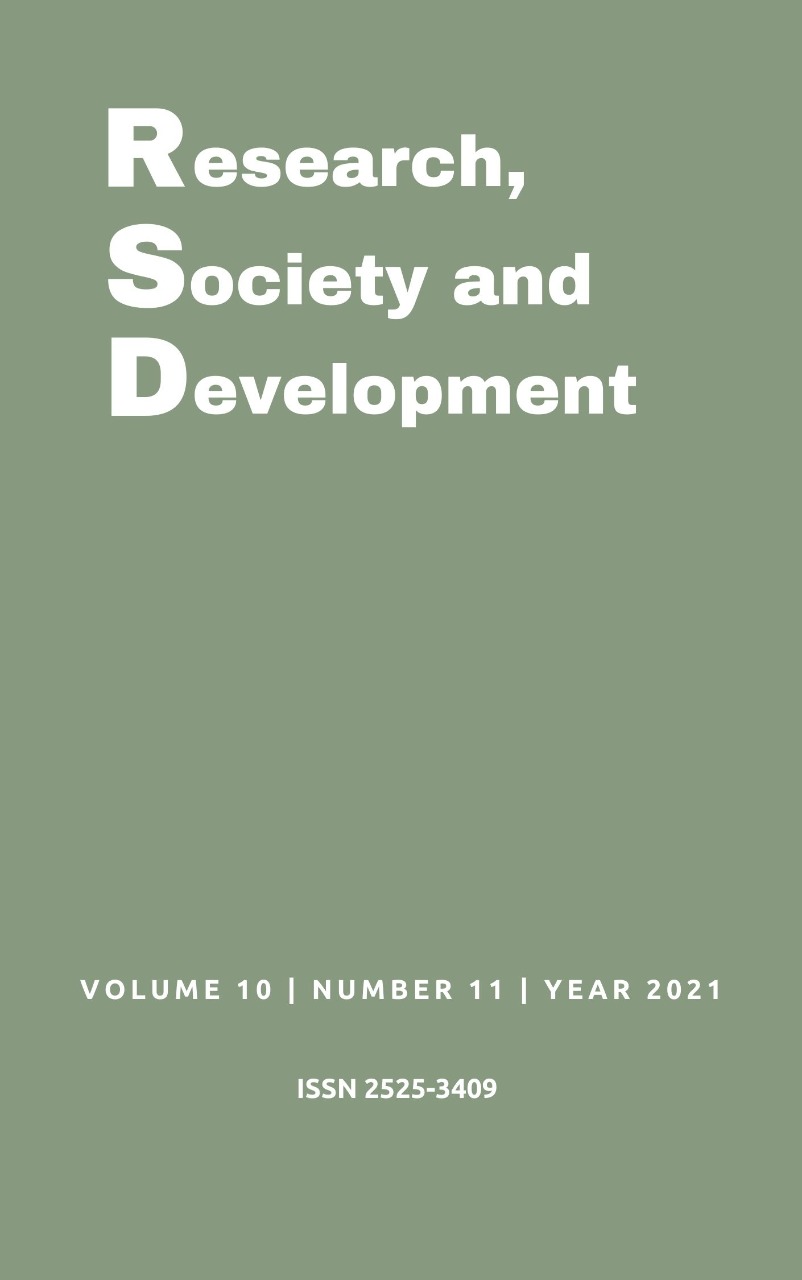Osteochondroma of the condyle: case report and a conservative alternative for surgical approach
DOI:
https://doi.org/10.33448/rsd-v10i11.19216Keywords:
Osteochondroma, Endaural approach, Condylectomy, Benign tumor, Temporomandibular joint.Abstract
Osteochondroma (OC) is one of the most common benign tumors of bone but is rarely found in the mandibular condyle. The aim of this case report is to demonstrate condylectomy through endaural approach (EA) as a conservative alternative for the treatment of the OC. A 60-year-old woman having an OC of 23 millimeters length in the mandibular condyle. The patient underwent a surgical procedure for tumor resection. To generate less morbidity, a conservative approach was performed.
References
Bachesk, A. B., Sessenta Junior, C. F., & Iwaki Filho, L. (2020). Surgical resection of osteochondroma in the mandibular condyle associated with directional orthodontic treatment: review of literature and a case report. Oral Surgery, 13(3), 280–290. https://doi.org/10.1111/ors.12493
Chen, M. J., Yang, C., Qiu, Y. T., Zhou, Q., Huang, D., & Shi, H. M. (2014). Osteochondroma of the mandibular condyle: A classification system based on computed tomographic appearances. Journal of Craniofacial Surgery, 25(5), 1703–1706. https://doi.org/10.1097/SCS.0000000000000898
Chiarini, L., Albanese, M., Anesi, A., Galzignato, P. F., Mortellaro, C., Nocini, P., & Bertossi, D. (2014). Surgical treatment of unilateral condylar hyperplasia with piezosurgery. Journal of Craniofacial Surgery, 25(3), 808–810. https://doi.org/10.1097/SCS.0000000000000699
Fan, H., Lv, X., Shi, J., Hu, J., & Luo, E. (2014). One-stage treatment to osteochondroma of the coronoid process and secondary facial asymmetry with coronoidectomy and reduction malarplasty: A case report and literature review. Journal of Oral and Maxillofacial Surgery, 72(9), 1870.e1-1870.e13. https://doi.org/10.1016/j.joms.2014.04.030
Giozet, A. F., Iwaki, L. C. V., Grossmann, E., Previdelli, I. T. S., Pinto, G. N. de S., & Iwaki Filho, L. (2019). Correlation between clinical variables and magnetic resonance imaging findings in symptomatic patients with chronic temporomandibular articular disc displacement with reduction: A retrospective analytical study. Cranio - Journal of Craniomandibular Practice, 37(6), 374–382. https://doi.org/10.1080/08869634.2018.1449360
Gonzalez-Lagunas, J. (2017). Is the piezoelectric device the new standard for facial osteotomies? Journal of Stomatology, Oral and Maxillofacial Surgery, 118(4), 255–258. https://doi.org/10.1016/j.jormas.2017.06.009
Grossmann, E., Remedi, M. P., Ferreira, L. A., & Carvalho, A. C. P. (2016). Magnetic resonance image evaluation of temporomandibular joint osteophytes: Influence of clinical factors and artrogenics changes. Journal of Craniofacial Surgery, 27(2), 334–338. https://doi.org/10.1097/SCS.0000000000002377
Lim, W., Weng, L., & Tin, G. (2014). Osteochondroma of the mandibular condyle: Report of two surgical approaches. Annals of Maxillofacial Surgery, 4(2), 215. https://doi.org/10.4103/2231-0746.147151
Ord, R. A., Warburton, G., & Caccamese, J. F. (2010). Osteochondroma of the condyle: review of 8 cases. International Journal of Oral and Maxillofacial Surgery, 39(6), 523–528. https://doi.org/10.1016/j.ijom.2010.02.015
Peroz, I. (2016). Osteochondroma of the condyle: case report with 15 years of follow-up. International Journal of Oral and Maxillofacial Surgery, 45(9), 1120–1122. https://doi.org/10.1016/j.ijom.2016.04.005
Pinto, G. N. de S., Grossmann, E., Iwaki Filho, L., Groppo, F. C., Poluha, R. L., Muntean, S. A., & Iwaki, L. C. V. (2019). Correlation between joint effusion and morphology of the articular disc within the temporomandibular joint as viewed in the sagittal plane in patients with chronic disc displacement with reduction: A retrospective analytical study from magnetic resonance. Cranio®, Feb 21, 1–6. https://doi.org/10.1080/08869634.2019.1582166
Roychoudhury, A., Bhatt, K., Yadav, R., Bhutia, O., & Roychoudhury, S. (2011). Review of osteochondroma of mandibular condyle and report of a case series. Journal of Oral and Maxillofacial Surgery, 69(11), 2815–2823. https://doi.org/10.1016/j.joms.2010.10.016
Santos, G. S., Nogueira, L. M., Sonoda, C. K., & Melo, W. M. de. (2014). Using Endaural Approach for Temporomandibular Joint Access. The Journal of Craniofacial Surgery, 25(3), 1142–1143.
Ward, B. B., Pires, C. A. S., & Feinberg, S. E. (2005). Osteochondromas of the mandible: Case reports and rationale for treatment. Journal of Oral and Maxillofacial Surgery, 63(7), 1039–1044. https://doi.org/10.1016/j.joms.2005.03.022
Wolford, L. M., Mehra, P., & Franco, P. (2002). Use of conservative condylectomy for treatment of osteochondroma of the mandibular condyle. Journal of Oral and Maxillofacial Surgery, 60(3), 262–268. https://doi.org/10.1053/joms.2002.30570
Wright, J. M., & Vered, M. (2017). Update from the 4th Edition of the World Health Organization Classification of Head and Neck Tumours: Odontogenic and Maxillofacial Bone Tumors. Head and Neck Pathology, 11(1), 68–77. https://doi.org/10.1007/s12105-017-0794-1
Yang, X. H., Zhang, P., Xu, J. H., & Hu, Y. J. (2015). An osteochondroma of the mandibular condyle. Journal of Craniofacial Surgery, 26(2), 567–569. https://doi.org/10.1097/SCS.0000000000001331
Downloads
Published
Issue
Section
License
Copyright (c) 2021 Matheus Herreira-Ferreira; Gustavo Nascimento de Souza-Pinto; Lilian Cristina Vessoni Iwaki; Liogi Iwaki Filho

This work is licensed under a Creative Commons Attribution 4.0 International License.
Authors who publish with this journal agree to the following terms:
1) Authors retain copyright and grant the journal right of first publication with the work simultaneously licensed under a Creative Commons Attribution License that allows others to share the work with an acknowledgement of the work's authorship and initial publication in this journal.
2) Authors are able to enter into separate, additional contractual arrangements for the non-exclusive distribution of the journal's published version of the work (e.g., post it to an institutional repository or publish it in a book), with an acknowledgement of its initial publication in this journal.
3) Authors are permitted and encouraged to post their work online (e.g., in institutional repositories or on their website) prior to and during the submission process, as it can lead to productive exchanges, as well as earlier and greater citation of published work.


